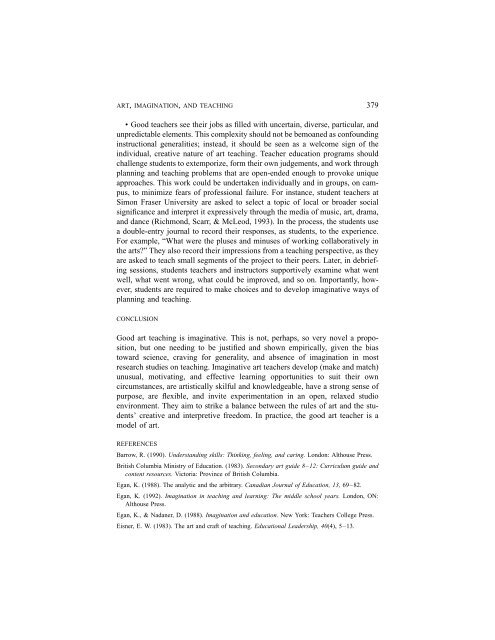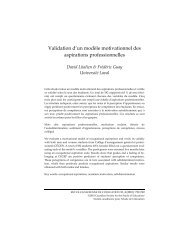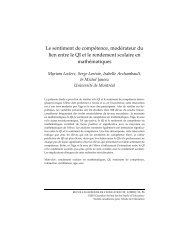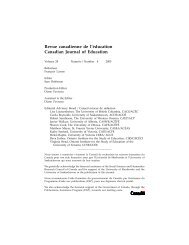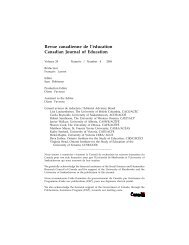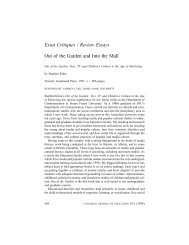Mireille Falardeau et Michel Loranger Le choix de stratégies ... - CSSE
Mireille Falardeau et Michel Loranger Le choix de stratégies ... - CSSE
Mireille Falardeau et Michel Loranger Le choix de stratégies ... - CSSE
Create successful ePaper yourself
Turn your PDF publications into a flip-book with our unique Google optimized e-Paper software.
ART, IMAGINATION, AND TEACHING 379<br />
• Good teachers see their jobs as filled with uncertain, diverse, particular, and<br />
unpredictable elements. This complexity should not be bemoaned as confounding<br />
instructional generalities; instead, it should be seen as a welcome sign of the<br />
individual, creative nature of art teaching. Teacher education programs should<br />
challenge stu<strong>de</strong>nts to extemporize, form their own judgements, and work through<br />
planning and teaching problems that are open-en<strong>de</strong>d enough to provoke unique<br />
approaches. This work could be un<strong>de</strong>rtaken individually and in groups, on campus,<br />
to minimize fears of professional failure. For instance, stu<strong>de</strong>nt teachers at<br />
Simon Fraser University are asked to select a topic of local or broa<strong>de</strong>r social<br />
significance and interpr<strong>et</strong> it expressively through the media of music, art, drama,<br />
and dance (Richmond, Scarr, & Mc<strong>Le</strong>od, 1993). In the process, the stu<strong>de</strong>nts use<br />
a double-entry journal to record their responses, as stu<strong>de</strong>nts, to the experience.<br />
For example, “What were the pluses and minuses of working collaboratively in<br />
the arts?” They also record their impressions from a teaching perspective, as they<br />
are asked to teach small segments of the project to their peers. Later, in <strong>de</strong>briefing<br />
sessions, stu<strong>de</strong>nts teachers and instructors supportively examine what went<br />
well, what went wrong, what could be improved, and so on. Importantly, however,<br />
stu<strong>de</strong>nts are required to make choices and to <strong>de</strong>velop imaginative ways of<br />
planning and teaching.<br />
CONCLUSION<br />
Good art teaching is imaginative. This is not, perhaps, so very novel a proposition,<br />
but one needing to be justified and shown empirically, given the bias<br />
toward science, craving for generality, and absence of imagination in most<br />
research studies on teaching. Imaginative art teachers <strong>de</strong>velop (make and match)<br />
unusual, motivating, and effective learning opportunities to suit their own<br />
circumstances, are artistically skilful and knowledgeable, have a strong sense of<br />
purpose, are flexible, and invite experimentation in an open, relaxed studio<br />
environment. They aim to strike a balance b<strong>et</strong>ween the rules of art and the stu<strong>de</strong>nts’<br />
creative and interpr<strong>et</strong>ive freedom. In practice, the good art teacher is a<br />
mo<strong>de</strong>l of art.<br />
REFERENCES<br />
Barrow, R. (1990). Un<strong>de</strong>rstanding skills: Thinking, feeling, and caring. London: Althouse Press.<br />
British Columbia Ministry of Education. (1983). Secondary art gui<strong>de</strong> 8–12: Curriculum gui<strong>de</strong> and<br />
content resources. Victoria: Province of British Columbia.<br />
Egan, K. (1988). The analytic and the arbitrary. Canadian Journal of Education, 13, 69–82.<br />
Egan, K. (1992). Imagination in teaching and learning: The middle school years. London, ON:<br />
Althouse Press.<br />
Egan, K., & Nadaner, D. (1988). Imagination and education. New York: Teachers College Press.<br />
Eisner, E. W. (1983). The art and craft of teaching. Educational <strong>Le</strong>a<strong>de</strong>rship, 40(4), 5–13.


